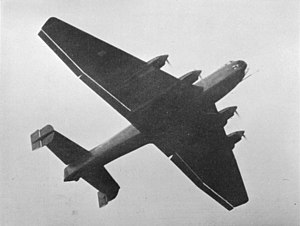Junkers Ju 89
| Ju 89 | |
|---|---|
 |
|
| Junkers Ju 89 in flight | |
| Role | Heavy bomber |
| Manufacturer | Junkers |
| First flight | 11 April 1937 |
| Introduction | 1938 |
| Retired | 1939 |
| Status | Retired |
| Primary user | Luftwaffe |
| Number built | 2 |
The Junkers Ju 89 was a heavy bomber designed for the Luftwaffe prior to World War II. Two prototypes were constructed, but the project was abandoned without the aircraft entering production. Elements of its design were incorporated into later Junkers aircraft.
From the very beginnings of the Luftwaffe in 1933, General Walther Wever, the chief of staff, realised the importance that strategic bombing would play in any future conflict. A Langstrecken-Grossbomber ("long-range big bomber") was needed to fulfill this role.
Under the Ural bomber programme, he began secret talks with two of Nazi Germany's leading aircraft manufacturers - Dornier and Junkers - requesting designs for a long-range bomber. The two companies responded with the Dornier Do 19 and the Junkers Ju 89 respectively, and the RLM (Reichsluftfahrtministerium, "Reich Aviation Ministry") ordered prototypes for both aircraft in 1935. It is reported that the RLM request asked for two prototypes and a prototype series of nine aircraft.
The Ju 89 and its competitor, the Dornier Do 19, both proved promising, but fell victim to a change of direction within the Luftwaffe. Wever was killed in a plane crash in 1936. His successors - Ernst Udet and Hans Jeschonnek - favoured smaller aircraft, since those did not require as much material and manpower. Also they were proponents of the dive bomber (Ju 87 Stuka) and the doctrine of close support and destruction of the opposing airforces on the 'battle-ground' rather than through attacking enemy industry.
...
Wikipedia
